At A Glance
- Bay Ridge was won by Eric Ulrich, but that’s not the whole story. He only took 34% of the vote, worse than any other Republican in the past 3 years.
- The low-turnout election provides lots of opportunities for analyzing the base of each local political party, and how they have shifted over time.
- Ulrich fits into a trend of declining prospects for Republicans in Southern Brooklyn.
Welcome to our analysis of the 2019 Public Advocate Special Election!
Why dig so deep into such a small, low-turnout election? Because honestly, it reveals information that has nothing to do with the Public Advocate race. Join us as we use the results to analyze both the Democratic and Republican party, and make some predictions about overall enrollment and the political climate of Bay Ridge moving into the future.
The Winners

Click to expand, or check out the interactive version.
While Eric Ulrich clearly won most of Bay Ridge, this isn’t the most important takeaway of the Special Election. The field was split among a ton of Democrats, with wildly different levels of funding and endorsements. Only Ulrich, and to a much lesser extent Manny Alicandro, represented the conservative viewpoint. They had that vote all to themselves. Thus, it didn’t take much to “win” a district in this Election cycle. We’ll look at the actual partisan map a bit later, which provides clearer results.
Regardless, it wasn’t a meaningless election. We haven’t had a low-turnout off-cycle election in Bay Ridge since Trump was elected. It provides a great opportunity to look at each
Jumaane’s Wide Appeal
For example, when we strip away the “winner” map and look at second and third place, a few interesting trends emerge. Jumaane Williams easily took second, owing mostly to a significant fundraising advantage and wide coverage, but also partly due to progressive grassroots support.
Without the local progressive groundswell of the past few years, one could imagine the map to be much more fractured. It might look more like ED 46062 in the southeast, which went for Ulrich, Yee and then Espinal… the only time either of the latter two candidates appear in the top 3 anywhere in the neighborhood.
The Bay Ridge Democrats & Michael Blake
More interesting is the third-place finish of Michael Blake, who was backed by the local Democratic Club. Districts he took second and third can be seen as a proxy for the extent of influence the Bay Ridge Democrats wield, or at least where their membership lives. It mostly corresponds to the same upper-middle-class areas along the water that Republicans tap into. This makes sense, since traditionally Bay Ridge politics has been a push and pull between the ideologies of mostly upper-middle-class home-owners. Things have been getting more diverse in the past few years, but this low-turnout election reveals that there is still has a long way to go to diversify both parties.
More tactically, the map also shows heavy Blake support around the primary flyering hub at 86th Street Station in the dead center of the district, and to a lesser extent all the local subway stations. The focus on commuters seems to also carry votes along the bus lines eastward into Bay Ridge into Dyker Heights.
Melissa Mark-Viverito
Mark-Viverito’s support further inland centers around rental-heavy 3rd and 5th Avenue, and the smaller more affordable single-family houses near the Gowanus Expressway. This reveals the limitations of the Bay Ridge Democrats influence, at least when their ground game isn’t fully brought to bear.
More importantly, the results reveal the often overlooked Latinx community in Bay Ridge, which actually is the second-largest racial demographic in the neighborhood, hovering in the 30% range. Their presence in Bay Ridge is larger than that of the Cantonese and Fujianese community, which are often politically centered due to their strength further into Dyker Heights and Bensonhurst.
Ulrich’s Lead and Unregistered Republicans
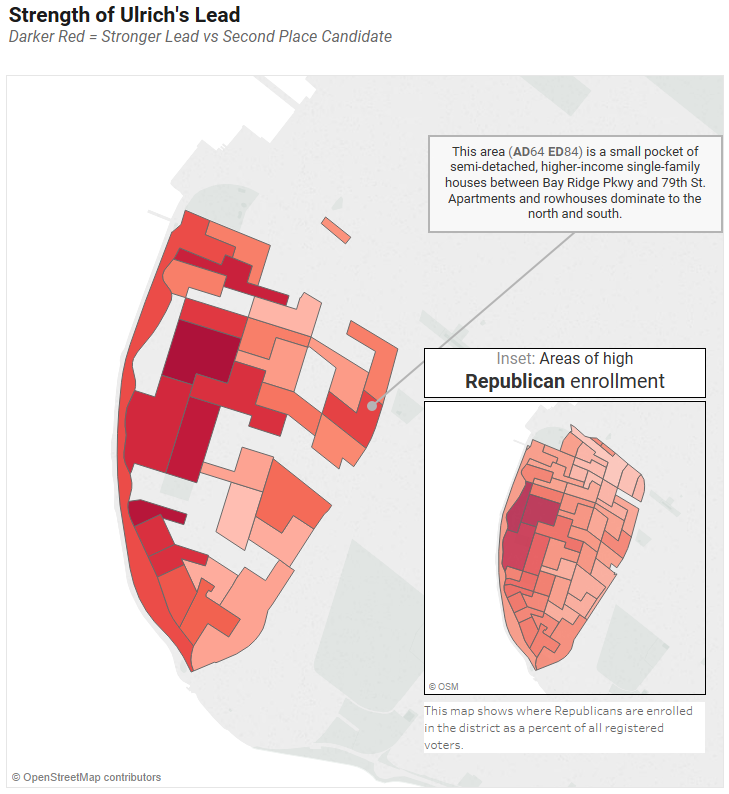
While the thinly-spread Democratic field highlighted some nuances in the local Democratic clubs, the unified Republican field exposed some Republican trends as well.
The map above shows how strongly Ulrich took first place. You can see that his lead sprawls further than the zone of high Republican enrollment (the inset map). It’s easy to assume from this that he had broad bipartisan support from liberals… but not so fast. Bay Ridge is a special case.
Republican-Voting Democrats
It’s long been assumed that a certain percentage of registered Democrats in South Brooklyn reliably vote Republican (
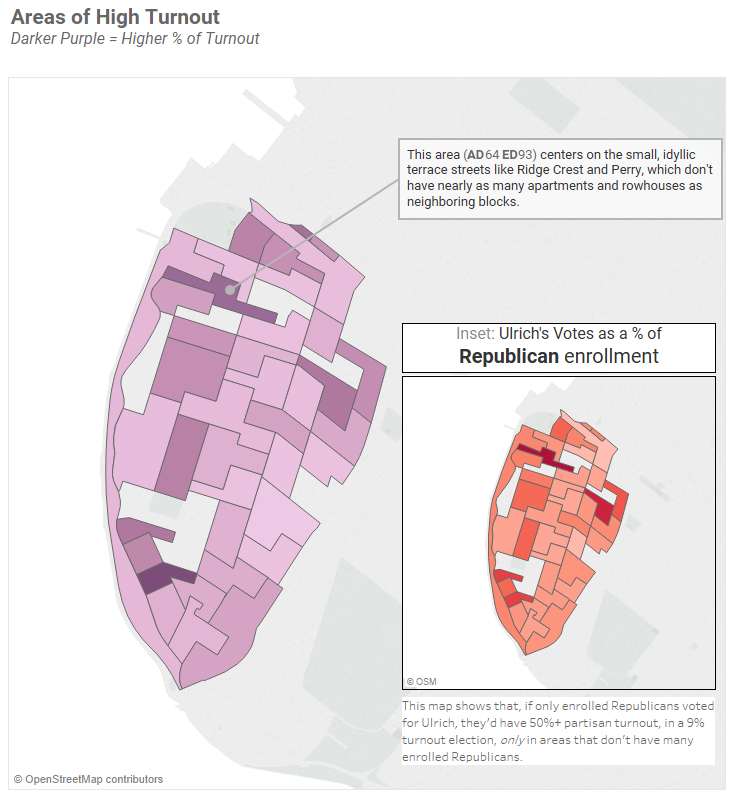
But if you look at the purple map above, you can see an unusual pattern. The Special Election only had a 10% turnout in Bay Ridge… but in some very specific areas, turnout boosted to 20% or more. These were also the only areas that Ulrich won but which didn’t have many registered Republicans.
Hypothetically, if everyone stayed 100% loyal to their party in this past race, Ulrich would have earned 50%+ of all registered Republicans in certain districts (see inset map). That’s way too high, so obviously some Democrats and unaffiliated voters came out to support him… but if Ulrich truly had bipartisan support, why would we see improved turnout only in specific electoral districts? And if he was somehow turning out droves of registered Republicans at a 50%+ rate, why aren’t we seeing that rate in areas of high republican enrollment? So what’s up with his increased turnout and performance along the entire coast of Bay Ridge, and the corridor centered around Bay Ridge Parkway (Doctors Row)?
The only viable explanation is that these are areas where there are registered Democrats who reliably vote Republican. They mostly are in high-income areas with single-family homes, which makes sense. So instead of turning out 50%+ of highly-engaged enrolled Republicans in seemingly random districts, I think that he instead turned out 20% of highly-engaged identified Republicans across the board, some of whom are enrolled
The Decline of the GOP in Bay Ridge
For decades, Southern Brooklyn Republican’s have used population-dense Bay Ridge as an anchor and home base. It still houses the headquarters of the State Conservative
But in the past five years, Republican control and conservative ideology have been slowly been worn away in the shadow of the Verrazzano Bridge. John Quaglione, majordomo to longtime Brooklyn GOP boss Marty Golden, lost to Democrat Justin Brannan in 2017. Golden himself fell a year later to Brannan’s friend and fellow Bay Ridge Democrat Andrew Gounardes. Dan Donovan, NYC’s only Republican in the US House of Representatives, narrowly lost Staten Island in 2018… but Bay Ridge and Southern Brooklyn, often a forgotten part of Donovan’s district, put his challenger Max Rose over the top. Even Nicole Malliotakis, wielding considerable name recognition from her Mayoral race in 2017, failed to convince much of Bay Ridge to vote for her while running for re-election to her seat in the NY State Assembly.
Ulrich was no exception to this trend.
Ulrich’s Performance in Context
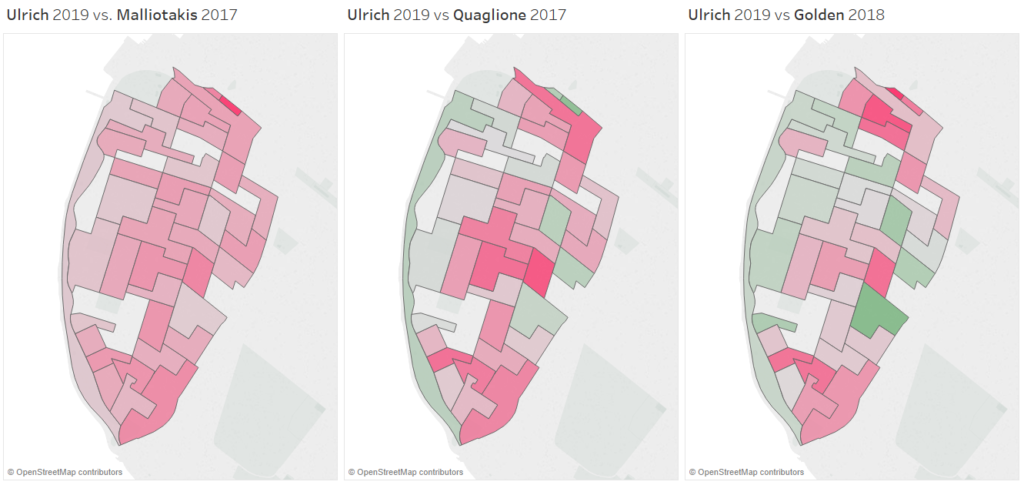
Click to expand, or check out the interactive version.
Ulrich vs. Malliotakis
Ulrich and Malliotakis positioned themselves as moderate Republicans. However, as you can see in the left-most map, Ulrich underperformed in every district compared to Malliotakis in terms of share of the vote captured. Specifically, he did worse along the avenues, where there are more renters and lower-income residents. This is interesting since both candidates essentially ran on the same campaign platform: “Mayor DeBlasio is bad“. It worked for Malliotakis, but seemingly, not for Ulrich.
Ulrich vs. Marty Golden & Co.
When compared to John Quaglione in 2017 (Middle) and Marty Golden in 2018 (Right), Ulrich did slightly better in more traditionally conservative, wealthy areas along the shore. One possibility for this is that Golden and Quaglione’s “culture-war” strategy, heavily dominated by Catholic ideology, was more a hindrance than a help among white-collar Bay Ridge conservatives. Golden and his cohorts heavy-handed, moralistic, fearmongering campaign tactics may actually have suppressed some of his economically-right-wing, socially-left-wing base (especially health and legal professionals). It seems like Ulrich may have brought them back around with a cleaner, more focused campaign.
Sadly, Ulrich’s cleaner campaign was one-note: “DeBlasio is bad.” Thus, Ulrich lost more than he gained overall, failing to convince low and middle-class high-turnout voters in the denser core of Bay Ridge that he had anything to offer.
Worse, it seems that the loss ratio of Republicans is only intensifying in Northern Bay Ridge, which is heavily Arabic and Fujianese. The implication is that the racism displayed by the Republican party on a national level may be unsalvagable at a local level, regardless of the
A History Of Diminishing Returns
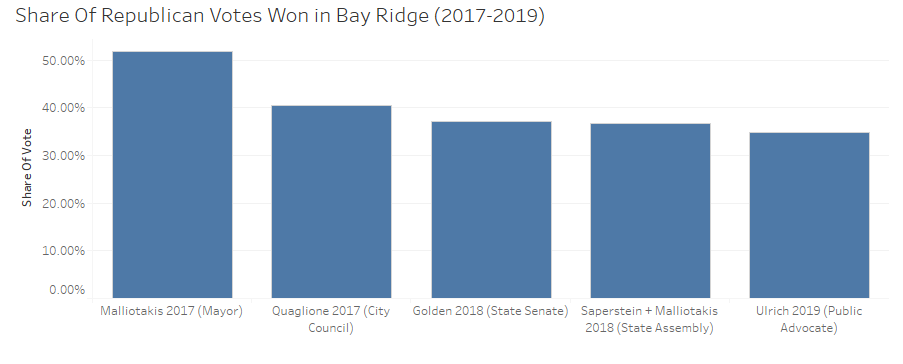
As we can see in the chart above, since 2017, Republican’s have been taking lesser and lesser shares of Bay Ridge’s vote.
2017 City Elections
In the 2017 Mayoral Race, Nicole Malliotakis hit a high water mark, winning 51% of Bay Ridge with a perfect storm of an unpopular mayor, and on-the-ground support from incumbents in the State Senate (Marty Golden), Congress (Dan Donovan), and the State Conservative Party (Mike Long and Gerry Kassar).
Meanwhile, however, the local City Council race saw many of Malliotakis’s voters switch back to the Democratic party after voting against DeBlasio, instead choosing Democrat Justin Brannan over Republican John Quaglione. Quaglione, who started as a moderate candidate, made a sudden Trump-style pivot part-way through his candidacy, choosing to focus on immigration, quality-of-life deterioration, and “shaking up” the establishment.
2018 State and Federal Elections
Quaglione’s boss Marty Golden would adopt a similar strategy, and do even worse. He took only 37% of Bay Ridge, two points less than his staffer a year earlier. Even with a decade of incumbency and vigorous support from Congressman Donovan and Assemblyperson Malliotakis, he was ousted after nearly 20 years in city and state politics.
Meanwhile, in the NY State Assembly races, Republicans fared even worse on average. Split between an Assembly District in the north, and an Assembly district in the south, the combined results of both Nicole Malliotakis and Steve Saperstein amounted to only 36% of the vote
Saperstein was the better off candidate, slightly outperforming Golden’s 40%. Still, he lost the neighborhood to Mathylde Frontus, who ran with almost no money or establishment connections, who was still recovering from a brutal Democratic primary that wasn’t officially called for weeks, delaying her ability to campaign. Saperstein, meanwhile, had a month head start and shared campaign staff and office resources with Golden’s campaign. Further, it’s unlikely he’d have been able to maintain that 40% win if his district extended to the northern section of Bay Ridge.
Malliotakis represents Northern Bay Ridge, on the other hand, and her performance pulled the average down. She lost much of Bay Ridge to first-time candidate Adam Baumel, who ran a campaign with almost no establishment support and even less money. Nicole even had the advantage of unused campaign posters, signs, and resources left over from her failed Mayoral bid a year earlier… not to mention name recognition. It was enough to handily defeat Baumel, but not enough to reverse the trend of diminishing returns in Brooklyn.
2019 Public Advocate Special Election
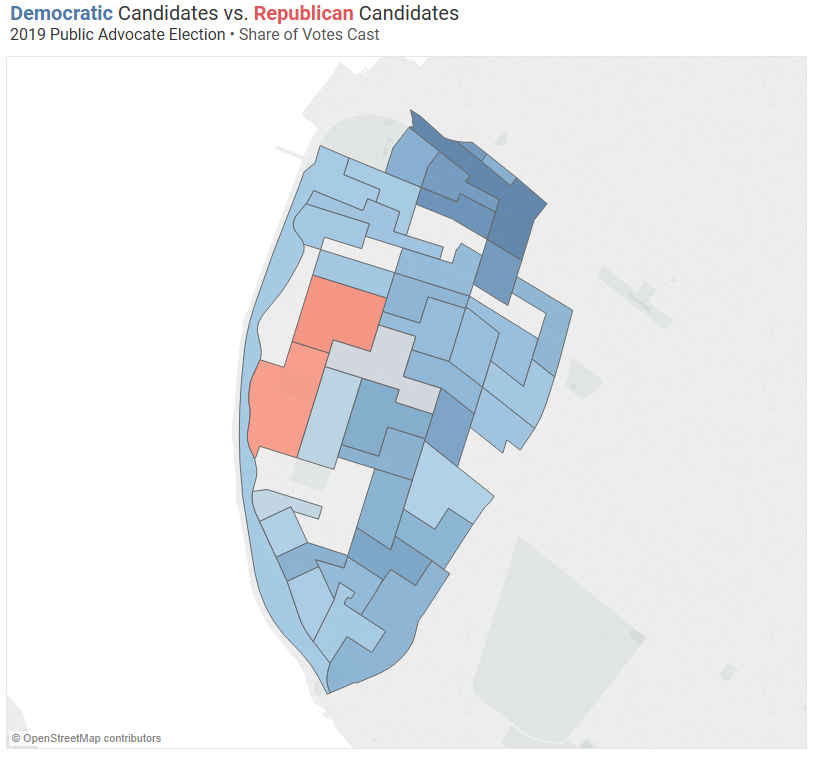
Donovan, Golden, and company were gone by 2019, with only Malliotakis holding a sliver of Bay Ridge, and her district office was shuttered (she shared a space with Golden). Essential income streams, patronage positions, and bully-pulpits were unavailable. Ulrich had to rely on a loose, bickering confederation of Conservative Party members, former Republican staffers, consultants, and Metropolitan Republican Club hangers-on to fuel his campaign.
It’s no surprise that Eric Ulrich continued the downward trend for the GOP, taking only 34% of Bay Ridge. In fact, if you look at the map above, you can see that he only took two Electoral Districts in Bay Ridge (likely three, since ED 64091 was inexplicably blank in election night results). Based on this, Ulrich wouldn’t have stood a chance against a single, unified Democratic candidate.
Party Enrollment Changes

For a longer-term view, we can look at enrollment trends above.
Democratic enrollment (left) in the past 2 years has been much stronger than either unaffiliated enrollment (right) and Republican enrollment (middle). Much of the Democratic voter increases have come from immigrant-heavy northern Bay Ridge, possibly reflecting long-term gains made by outreach from the Khader El-Yateem primary. Much of El-Yateem’s strategy focused on voter registration in Arabic portions of the district. We can also see higher voter registration for Democrats in the center of Bay Ridge, centered around each subway stop. These have been high-priority areas for nonpartisan voter registration drives in the past few years.
Conversely, Republican enrollment has declined in heavily immigrant areas, almost certainly a result of local Republicans explicitly adopting Trump-style campaign tactics and messaging. The only area Republican enrollment increased is in the southern portion of the district, which compromises the NORC (Naturally
As a side-note to Republican enrollment trends, unaffiliated enrollment declined slightly within the “Gold Coast” of Bay Ridge, the central waterfront area comprising most of the million-dollar mansions, and Bay Ridge Parkway, which has similarly expensive rowhouses. It’s possible that we are seeing these areas becoming more partisan. Conversely, Southern Bay Ridge as a whole is slightly less partisan, with the highest share of unaffiliated voters registering there.
Predicting Future Trends
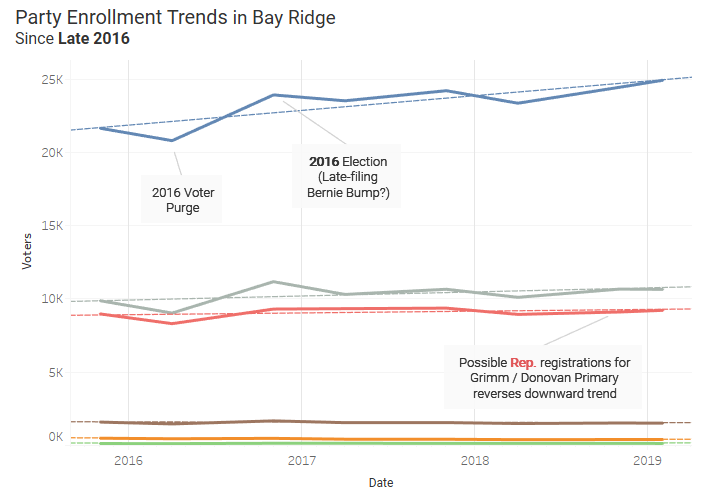
Sadly, our maps only go back as far as 2017, due to changing Electoral District layouts. But if we look at Bay Ridge as a whole, we can get data from 2015 and earlier. Importantly, we can see the effect of the Trump era on Bay Ridge politics and enrollment.
We can see the initial dip from the 2016 voter purge on the left, which disproportionately affected Democrats. Directly afterwards, we see a massive rebound in Democratic enrollment. This could be simply a usual Presidential Election enrollment surge, but there are a few bits of evidence that it isn’t.
Firstly, Bernie Sanders disproportionately won Bay Ridge and Southern Brooklyn versus Hilary Clinton. Secondly, New York has a notoriously delayed system for party registrations and changes. It is entirely possible that this massive Democratic and Unaffiliated boost in late 2016, which barely occurred for Republicans, is the result of late-registering Sanders supporters that were attempting to vote in time for the primary.
If this analysis is correct, we can expect a similar boost in Democratic enrollment for 2019 and 2020 as Sanders relaunches his presidential campaign and engages with new voters. It also sets the stage for a shift in Democratic messaging and voter engagement, focusing on economic justice, an issue Republicans have increasingly abandoned in local elections.
Disclaimer: The above analysis is by our co-host and producer, Daniel Hetteix. It’s based on years of living in, engaging with, and observing Bay Ridge politics, in addition to publically available electoral and demographic data. It isn’t the only possible interpretation though! We encourage you to interpret and consider the data for yourself, which is all available via. Tableau. Feel free to comment and provide additional insight in the comments and on social media: data deserves to be free!
Thanks for looking into this and sharing your analysis. It really makes for interesting thinking about the future of Bay Ridge.